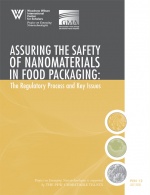Use of Nanomaterials in Food Packaging Poses Regulatory Challenges
Report Uses Product Scenarios to Examine the Oversight and Regulatory Pathways to Commercialization
 Engineered nanoscale materials (ENMs), which contain novel properties that offer potential benefits for use in food packaging, raise new safety evaluation challenges for regulators and industry, according to a report released today by the Project on Emerging Nanotechnologies (PEN) and the Grocery Manufacturers Association (GMA).
Engineered nanoscale materials (ENMs), which contain novel properties that offer potential benefits for use in food packaging, raise new safety evaluation challenges for regulators and industry, according to a report released today by the Project on Emerging Nanotechnologies (PEN) and the Grocery Manufacturers Association (GMA).
The food-packaging industry, food companies and consumers all share an interest in ensuring that any possible safety questions are identified and are carefully evaluated and resolved before marketing packaging materials that contain ENMs, according to the report authored by former Food and Drug Administration (FDA) policy official Michael R. Taylor.
The PEN-GMA report, Assuring the Safety of Nanomaterials in Food Packaging: The Regulatory Process and Key Issues, was a result of an effort by experts from government, industry and the public interest community to examine the path of a number of hypothetical nanotechnology food packaging applications through the current regulatory system. The regulatory system for food packaging is scientifically rigorous and extraordinarily complex, both legally and scientifically. This first-of-its-kind analysis provides a better understanding of the potential regulatory issues on the horizon for nanotechnology-enabled packaging – an advantage for industry, consumers and regulatory agencies such as FDA and the Environmental Protection Agency (EPA).
“The system is not widely understood and legitimate questions have been raised about how it would apply to nanoscale substances used in food packaging,” says Taylor, who is currently a research professor at the George Washington University School of Public Health and Health Services. “Those companies developing ENMs for use in packaging will need to work closely with FDA and EPA to make sure the questions identified in this report concerning potential risks are answered.”
Consumer acceptance of the use of nanomaterials in food packaging is very important and will be greatly dependent on the demonstrated benefits and safety of the new packaging products, according to PEN Director David Rejeski.
“The benefits of using nanomaterials in the next generation of food packaging are nothing short of amazing, but we have to make sure these materials will not pose any harm down the line,” Rejeski says.
Nanotechnology has the potential to reshape the food packaging industry in the decades ahead and these product scenarios will help set a roadmap toward both regulatory and consumer acceptance successes.
“Clearly, nanotechnology offers tremendous opportunities for innovative developments in food packaging that can benefit both consumers and industry. However, before these packaging innovations can be brought to market, we must ensure that the food-packaging industry, through working closely with government, understands the regulatory framework currently in place along with its many requirements,” says Robert Brackett, GMA’s chief science officer.
June 25, 2008
Summary
Engineered nanoscale materials (ENMs), which contain novel properties that offer potential benefits for use in food packaging, raise new safety evaluation challenges for regulators and industry, according to a report released today by the Project on Emerging Nanotechnologies (PEN) and the Grocery Manufacturers Association (GMA).
Files
Michael R. Taylor Presentation
